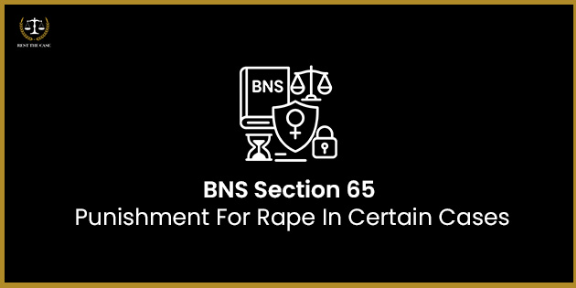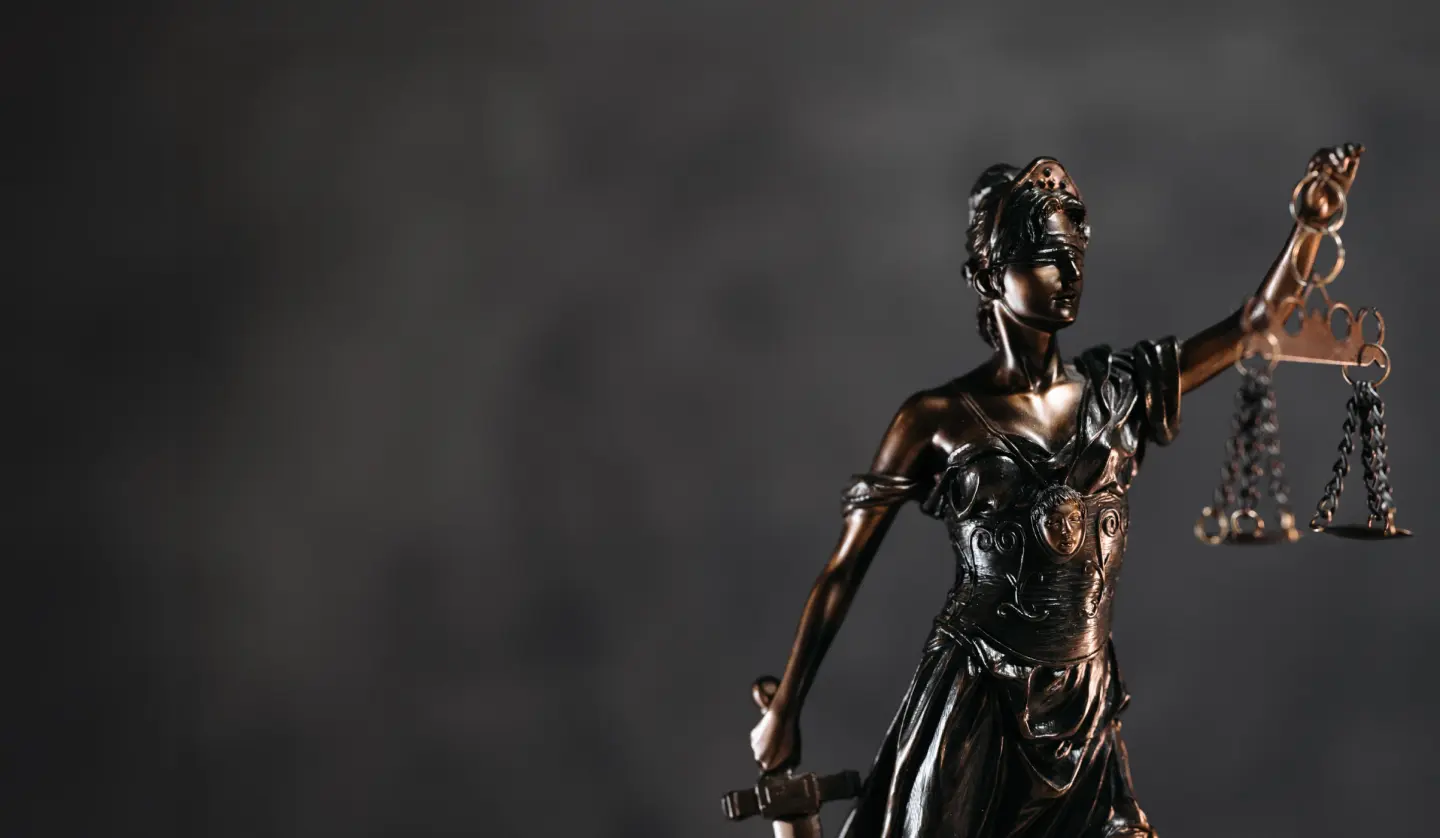BNS
BNS Section 65 - Punishment For Rape In Certain Cases

3.1. Example 1: Punishment and Lifetime Jail
3.2. Example 2: Money for the Victim's Recovery
4. Key Improvements and Changes: IPC (Old Law) to BNS 65 (New Law) 5. Leading Case Laws5.1. Nazir Hussain & Ors. v. State of Assam
5.2. State of Odisha v. Ramesh Nayak (Cuttack Sessions Court, October 2025)
BNS Section 65 is the law that gives the maximum possible punishment for the crime of rape against a girl who is a child or a minor. This section shows that the new law treats crimes against children with the highest level of strictness. In simple words, this rule makes sure that anyone who commits this horrible crime against a young victim faces jail for the rest of their life or even the death penalty. It is meant to be a terrifying warning to all offenders. This law is part of the new code, the Bharatiya Nyaya Sanhita (BNS), and it takes the place of the old, equally tough sections in the Indian Penal Code (IPC), specifically IPC 376(3) and IPC 376AB.
Legal Provisions
BNS Section 65 covers two main situations, depending on the age of the victim:
- Rape of a woman under sixteen years of age:
"Whoever, commits rape on a woman under sixteen years of age shall be punished with rigorous imprisonment for a term which shall not be less than twenty years, but which may extend to imprisonment for life, which shall mean imprisonment for the remainder of that person's natural life, and shall also be liable to fine; Provided that such fine shall be just and reasonable to meet the medical expenses and rehabilitation of the victim; Provided further that any fine imposed under this sub-section shall be paid to the victim."
Illustration: A person, 'X', is found guilty of raping a 14-year-old girl. Since the victim is under sixteen, 'X' faces a minimum of 20 years in jail. This prison term can last for the rest of his natural life. On top of that, 'X' must pay a large fine specifically to cover the girl's medical treatment and help her rebuild her life.- Rape of a woman under twelve years of age:
"Whoever, commits rape on a woman under twelve years of age shall be punished with rigorous imprisonment for a term which shall not be less than twenty years, but which may extend to imprisonment for life, which shall mean imprisonment for the remainder of that person's natural life, and with fine or with death: Provided that such fine shall be just and reasonable to meet the medical expenses and rehabilitation of the victim: Provided further that any fine imposed under this sub-section shall be paid to the victim."
Illustration: A person, 'Y', is convicted of raping a 10-year-old girl. The punishment here starts at 20 years in jail and can be extended to imprisonment for the entire natural life of 'Y'. Crucially, the court also has the option to award the death penalty. A fine for the victim's recovery is also mandatory.
Simplified Explanation of BNS Section 65
This section of BNS creates a clear and tough penalty system for sexual crimes against minors. It essentially says that if you commit rape against a child, the legal system will treat it with maximum severity.
- For Teen Victims (Under 16): The offender gets a minimum of twenty years in jail. The court can increase this to a life sentence, meaning they will spend their entire remaining life behind bars.
- For Young Child Victims (Under 12): The punishment is the same as above (minimum 20 years to life), but the court can also give the death penalty as an option, reflecting the extreme gravity of the crime.
- Crucial Component: Victim First: A major part of this law is the mandatory fine. This money is not meant for the government; it is exclusively for the victim. It ensures that the person who committed the crime pays for the victim's medical bills, counselling, and overall rehabilitation.
Practical Examples
Here are two very simple examples to show how this powerful law is used in court:
Example 1: Punishment and Lifetime Jail
A 40-year-old man is found guilty of assaulting a 15-year-old girl. Under BNS Section 65, the judge must give him a very long prison sentence; it cannot be less than 20 years. Because the crime is so bad, the judge decides the man should never be free again and sentences him to jail for the rest of his life. This shows the court is using the maximum punishment possible to protect young teens and keep the criminal permanently locked up.
Example 2: Money for the Victim's Recovery
In a different case involving a 10-year-old child, the criminal is sentenced to the death penalty. But the law does not stop there. The judge also gives a mandatory order to the criminal to pay a large fine, let's say ₹20,00,000 (twenty lakh rupees). The law makes sure this entire amount must go directly to the child's family. This money is a lifeline, used only to pay for the child's ongoing hospital care, emotional counselling, and any special support needed for her long-term recovery.
Key Improvements and Changes: IPC (Old Law) to BNS 65 (New Law)
This table uses simple words to show how the law has changed, moving from the old Indian Penal Code (IPC) sections to the new BNS Section 65.
Feature | The Law Before (IPC 376, 376AB) | The Law Now (BNS Section 65) | What is better and clearer now? |
Money for the Victim's Recovery | This payment was not guaranteed. A judge could order the criminal to pay a fine, but it was up to the judge's choice. | This payment is now 100% mandatory (required). The fine must cover the victim’s medical bills and therapy. | Guaranteed Support: The law forces the criminal to pay for the victim's recovery. The survivor is legally promised financial help. |
"Life Imprisonment" Meaning | Sometimes, "life in jail" could be confusing and might have led to the criminal getting out early. | It is clearly written as "jail for the remainder of that person's natural life." | No Early Release: The law is now clear: for the worst crimes, the criminal stays locked up until the day they die. |
Law Organization | The serious punishments for children under 16 and under 12 were spread out over different parts of the IPC. | All the severe punishments for crimes against minors are now perfectly grouped into one clear section (BNS 65). | Easier to Use: The law is simpler for judges and police to use correctly and quickly. |
Punishment Severity (Under 12) | Allowed for life imprisonment or the death penalty. | Still allows for life imprisonment or the death penalty. | Toughness Maintained: The law remains equally tough, ensuring the highest punishment for the worst crimes against young children. |
Leading Case Laws
Section 65 of the Bharatiya Nyaya Sanhita (BNS) lays down stringent punishment for offences involving the rape of minors. Indian courts have started interpreting and applying this provision strictly to ensure justice and victim protection. The following leading case laws highlight how courts are enforcing Section 65 BNS to strengthen accountability and safeguard child victims.
Nazir Hussain & Ors. v. State of Assam
Issue:
In the case of Nazir Hussain & Ors. v. State of Assam, the accused were charged in Assam for the kidnapping and sexual assault of a minor girl, leading to offences under Section 65 of the Bharatiya Nyaya Sanhita (BNS). The victim’s official birth certificate confirmed that she was below 16 years of age at the time of the incident. The primary legal issue before the court was whether Nazir Hussain and the other accused could seek anticipatory bail under Section 65 BNS, given the new provisions restricting bail for such offences.
Judgement:
The Gauhati High Court decided that the law bars anticipatory bail if anyone is accused under Section 65, not just when combined with other serious sections. The judge refused bail for Nazir Hussain because of direct allegations of rape of a minor under Section 65, but allowed bail for the other three since they weren’t specifically charged with rape. The decision clarified that the court gives priority to victim protection for child sexual offences.
State of Odisha v. Ramesh Nayak (Cuttack Sessions Court, October 2025)
Issue:
In State of Odisha v. Ramesh Nayak, a 55-year-old man from Cuttack, Odisha, was prosecuted for the sexual assault of an 8-year-old girl. The police invoked Section 65 of the Bharatiya Nyaya Sanhita (BNS), which specifically addresses the rape of minors under 12 years of age. The prosecution produced medical reports, witness statements, and the victim’s school certificate and hospital records to confirm her age and substantiate the charges.
Judgment:
The trial court convicted the accused and sentenced him to 20 years of rigorous imprisonment, along with a fine to fund the victim’s medical care and rehabilitation. The court applied Section 65 BNS strictly, highlighting its purpose of imposing severe punishment for child rape and ensuring financial and emotional support for victims. This judgment demonstrates the judiciary’s commitment to strictly enforcing the new law to safeguard young children from sexual violence.
Frequently Asked Questions
Q1. Why was the old IPC law changed to BNS 65?
The government updated the law to make the entire legal code clearer and simpler. For child rape, BNS 65 was written to make the punishment even tougher and, crucially, to make sure victims are legally guaranteed financial support for their recovery.
Q2. What is the biggest difference between the old law and BNS 65?
The biggest difference is the mandatory fine. The BNS 65 forces the criminal to pay for the victim's medical and rehabilitation costs, a huge help for the family.
Q3. Is BNS Section 65 a bailable or non-bailable offense?
It is a non-bailable offense. This means the accused person cannot walk out on bail easily. They are held in jail while the case proceeds, as the crime is too serious.
Q4. What is the punishment for the offense under BNS Section 65?
(1) Victim under 16: Minimum 20 years in jail, up to Jail for life. (2) Victim under 12: Minimum 20 years in jail up to life imprisonment, or the death penalty.
Q5. What is the fine imposed under BNS Section 65?
A mandatory fine is imposed. The money must be a fair amount to fully cover the victim's medical treatment and recovery expenses, and it is paid directly to the victim.






